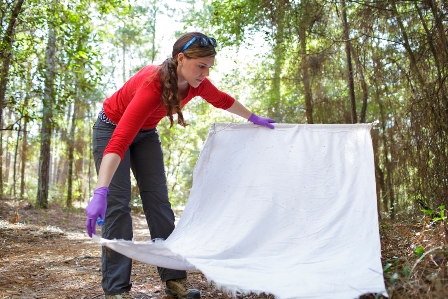
Gainesville, Florida — University of Florida researchers have discovered a rare virus that belongs to the family Arenaviridae. Some arenaviruses are associated with severe hemorrhagic disease and has had a significant mortality in people in South America and sub-Saharan Africa. The virus was thought to have vanished four decades ago.
Dr. Katherine Sayler, and her team of researchers, found the virus in Lone Star ticks that were collected from Manatee, O’Leno, and San Felasco State Parks.
Researchers said that out of all the Lone Star ticks trapped, collected, and cultured from North Central Florida, 10 percent of the ticks were infected with the Tacaribe virus.
Tacaribe virus (TCRV) was first isolated from 11 Artibeus species bats captured in Trinidad in the 1950s during a rabies virus surveillance program. Despite significant effort, no evidence of infection of other mammals, mostly rodents, was found, suggesting that no other vertebrates harbored TCRV. For this reason, it was hypothesized that TCRV was naturally hosted by Artibeus bats. This particular virus has not been found in rodents as other similar arenaviruses associated with causing hemorrhagic fever.
“This finding is exciting because it expands the range in which these viruses might be circulating in the environment,” Dr. Sayler said in a university news release. “It also raises some really interesting questions about human risk,” she added.
“We never thought we would find an arenavirus in a tick. These types of viruses are usually transmitted by rodents,” Dr. Sayler noted.
Although the Tacaribe virus had previously been found in bats, recent studies indicate that bats are not the natural reservoir host, and efforts to find the virus in other mammals have failed.
“We still don’t know which animal is the natural host of this virus, and whether ticks have harbored the virus for a long time, or if this is something new,” Dr. Sayler said. “Without knowing if local rodents are a major reservoir of the virus, the extent that Floridians are sickened by the virus, and whether ticks can transmit the virus to humans, it makes it hard for us to know if and when there would be an outbreak. Clearly, much more work must be done.”
According to the Centers for Disease Control, Lone Star ticks are aggressive human biters and do carry Lyme disease.
“We need to use some of the tools that we have at UF to determine if the virus has been around and circulating for a long time, or if it has been absent from Florida and was introduced,” Dr. Sayler said. “Health care professionals should also be aware of the potential tick-transmitted pathogens that occur besides the one that causes Lyme disease. Medical doctors can’t be aware of every emerging tropical disease, but if we have greater awareness of emerging diseases, we can move forward from a proactive surveillance effort instead of from a reactive effort, when there is suddenly a huge outbreak and a crisis situation,” she added.
Arenaviruses can in fact cause hemorrhagic fever. Most arenavirus infections cause a flu-like illness that starts within a week of exposure. The initial symptoms are often mild, but may quickly worsen.
Symptoms of viral hemorrhagic fever include fatigue, fever, weakness, dizziness, and muscle aches; patients with more severe infections show bleeding under the skin, internal organs, or even from bodily orifices like the mouth, eyes, or ears. Some patients develop severe diarrhea that may also be bloody, and severely ill patients present with shock, delirium, seizures, kidney failure, and coma that often ends in death.
Patients with viral hemorrhagic fevers usually receive only supportive therapy; there is no other established cure for viral hemorrhagic fevers.
According to Dr. Sayler, the cultures taken from the ticks tested 99 percent identical to the only remaining sample from a virus found in Trinidad in the late 1950s.
Dr. Sayler said that people who are bitten by a tick should try to save the tick for further analysis by a medical professional. If possible, put the tick in a ziplock-type bag and place it in a freezer if you cannot get it to a doctor immediately.
Dr. Sayler said she would continue her work at UF, which would include searching for more isolates of the virus for genetic comparison.
“We need to figure out what mammals have it here in Florida and how it got here,” Dr. Sayler said.
This is the first time this virus has been found in the United States.
